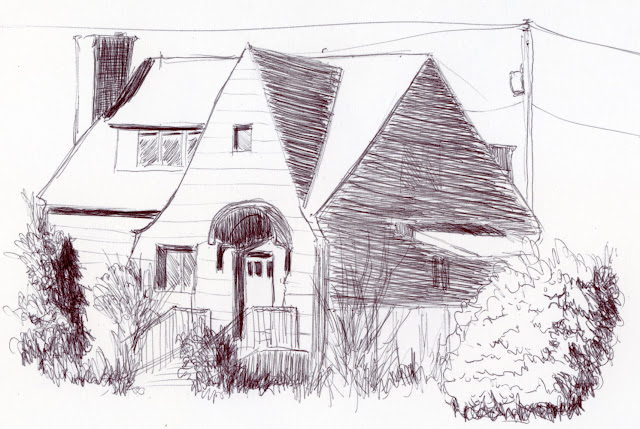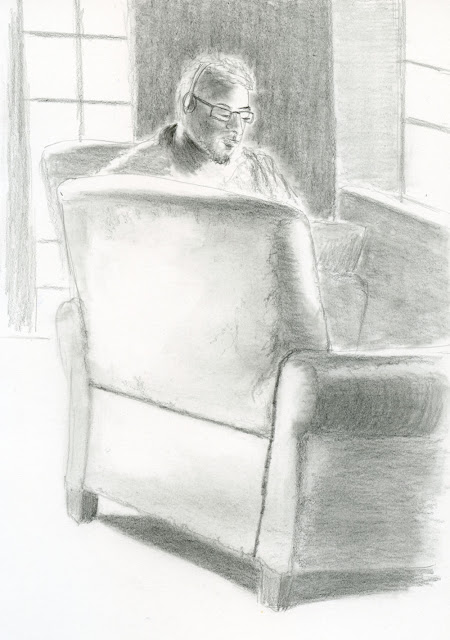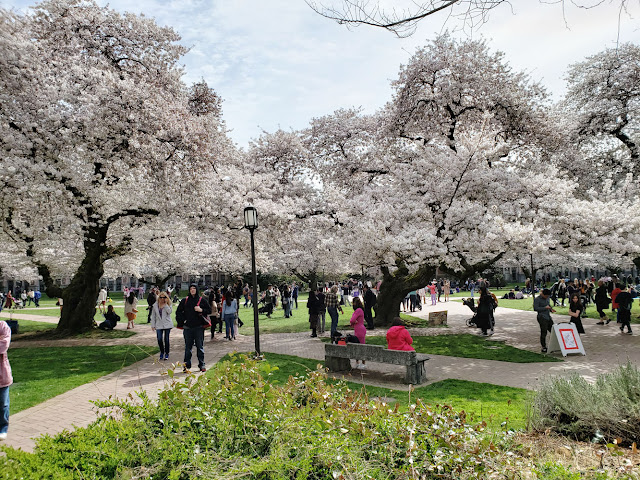 |
| 3/17/19 watercolor pencils spritzed with water |
I’ve
been a big fan of Stillman & Birn sketchbooks ever since they came onto the scene around the time I started
sketching. Although I’ve used various S&B editions (the New Jersey company offers
seven types of paper in hardcover and softcover) sporadically for urban
sketching, I have consistently used Alpha,
Beta and Epsilon editions in my studio. Any time I work at my desk, whether
I’m using water-soluble pencils, colored pencils, graphite, watercolor, ink or
markers, I reach for one of these books. Most of them are filled with still
lives as well as swatches and tests I make whenever I try a new product.
My Zeta book, which contains 180-pound
white paper, has gotten the lightest workout. Its smooth surface is the same as
the lighter-weight Epsilon, and I haven’t had much need for a
water-media-friendly heavy paper that’s also smooth. While I’ve gone through
many multiples of Alpha, Beta and Epsilon, my single Zeta still had more than
half its pages remaining.
When
Eduardo Bajzek’s workshop in Porto
last summer inspired me to make graphite a permanent part of my urban sketching
kit, I was thrown into a tizzy. The
student-grade 140-pound Canson XL watercolor paper I had been happily using for years in my DIY sketchbooks
was too toothy to use with graphite. After unsuccessfully trying to find a
single type of paper that would work with all the media I like to use, I
settled for carrying two signatures – one with smooth Canson Bristol for use with graphite; one with my usual Canson XL
for everything else.
That
wasn’t an ideal solution, though, and I was still restless. With renewed fervor
brought on by thoughts of minimizing my entire sketch kit, I started wondering
again: Can’t I find a single paper that would meet all my needs if I’m willing to make some
compromises? And that’s when I remembered Stillman & Birn’s Zeta.
I knew its smooth surface would be great with graphite
because I had already tried graphite with Epsilon. Its 180-pound weight is
certainly heavy enough for the light washes of water I put on watercolor
pencil, but I had grown fond of Canson XL’s tooth. I also hadn’t used Zeta
consistently enough to feel familiar with it when using a variety of media. I
decided to throw my full arsenal of typical urban sketching materials onto the 31 remaining pages in the Zeta book for
some everyday-carry, real-world testing.
That
was a month ago. I’ve now filled the book, and I’ve had opportunities to use
all the media I typically use on location; shown here are a few examples.
The ballpoint sketch of a house near
Green Lake turned out to be an interesting example of how carrying a new type
of sketchbook can open new possibilities. Normally I would probably reach for
colored pencils to sketch this house, but because I knew I had Zeta paper in my
hands, I tried ballpoint instead. I had been focusing on graphite as a medium
that requires a smooth surface (to achieve the soft, smudgy tones that appeal
to me), but ballpoint, too, is much more pleasant when used on smooth paper.
 |
| 2/26/19 ballpoint pen |
As
expected, markers and brush pens were a joy to use for the gesture sketches of people at Hing Hay Park, and there’s no
danger of bleed-through.
 |
| 3/2/19 Pitt Artist Brush Pen, Zebra brush pen |
Also
as expected, I was able to build gradual tones with graphite beautifully in
this sketch at a coffee shop. Zeta’s
surface allowed highlights to be easily and cleanly erased.
 |
| 3/4/19 graphite |
I
was more skeptical about how Zeta would perform with my favorite coloring
medium – water-soluble colored pencils. I appreciate the rich texture that Canson
XL’s tooth imparted, especially with organic subject matter like trees and rocks.
This sketch of the grassy hill at Gas Works Park came out OK, and the Caran d’Ache Museum Aquarelle pencils showed
more texture than I was aware of in Zeta, but it was still smoother than I
like. Colors seem slightly less vibrant on Zeta’s sizing (but not enough to be
a deal-breaker).
 |
| 3/16/19 watercolor pencils |
One
of my favorite techniques when sketching trees and foliage is to use a spritzer instead of a waterbrush to
intensify the hues of watercolor pencil pigments. If a paper could not handle
this technique, it would be a deal breaker, so I had made a preliminary test
with an imaginary tree last month.
This time, I sketched some real trees on location (top of post). I still miss that Canson
texture, but I was pleased that Zeta’s weight handled spritzing sufficiently.
I
made several sketches like this one of an excavator that incorporate several media – a Faber-Castell Pitt Big Brush marker, watercolor pencils and even a
little ballpoint ink. This mix of media is typical for me, and the paper took
all of them well.
 |
| 3/18/19 watercolor pencils, ballpoint, Pitt Artist Brush Pen |
Book
filled and real-world testing completed, I went on to analysis:
Pros:
- The
biggest and most important benefit of using a Zeta sketchbook is that the paper
is compatible with all the media I typically use in the field. I would no
longer need to consider which type of paper to bring when I leave the house or
carry more than one type, just in case I change my mind. Though it’s not ideal with everything, it is acceptable with everything. In fact,
once I had accepted that Canson’s tooth wasn’t there, I started to really enjoy
Zeta’s easy surface and substantial weight that seem to take everything with
aplomb. I like Zeta a lot – much more than I expected.
- Zeta’s
surface is identical on both sides. I know that seems like a non-issue, but it
has always annoyed me that student-grade Canson XL is slightly toothier on one
side than the other. I was used to it, but it wasn’t until I used Zeta for a
continuous month that I realized how pleasurable it is to have a reliable, consistent
surface.
- Although
I have generally enjoyed the hand bookbinding process the past six years,
especially the flexibility of using any type of paper, lately the process has
felt more burdensome than fun. In particular, I don’t enjoy gluing and preparing
the covers. The idea of filling a book and simply grabbing a readymade one from
the store is very appealing. (The one exception is when I travel. . . more
thoughts on that after my analysis.)
Cons:
- In
my ongoing quest to make my sketch kit as lean as possible, a significant
drawback of the Zeta softcover sketchbook is that it is more than twice as
thick as a single signature of paper and weighs nearly three times as much.
- Colors
do not look quite as vibrant on Zeta’s sizing.
- I often
miss Canson XL’s cold press texture that gives an appealing grittiness to
watercolor pencil sketches. (But of course, that same tooth is what became
intolerable with graphite.)
- The
material cost of a 96-page handbound sketchbook – paper, cardboard covers, thread
– is about $6.50. The cost of a 52-page Zeta sketchbook is $15.19 (cost for
both based on Blick prices). That means a Zeta sketchbook costs more than four
times a handbound book. Price is certainly not the main consideration for
binding my own books all these years, but it’s one factor.
Thoroughly
considering all of these pros and cons as I filled the Zeta book, I made the
decision to use Zeta as my regular sketchbook going forward. It’s the first
major everyday-carry sketchbook change in nearly six years, so I’m not one to
make this type of change lightly. But I haven’t stockpiled a lifetime supply,
either – I always give myself permission to make new choices as circumstances
(or media) change. For now, I’ve purchased two more, which will last me until
this summer’s travel season. And that brings me to . . .
Travel considerations
I
have one special and important consideration related to handbinding. Although I’m
relieved to give up bookbinding in exchange for a reliable, off-the-shelf
sketchbook, the one time I truly enjoy bookbinding is when I travel. Having a
travel sketchbook that stands alone as a self-contained unit for that trip
appeals to me immensely. When I return, I love using maps, tickets, postcards
and other ephemera from my travels as the collage for my book covers. (See
examples of some travel sketchbooks: Portugal,
Japan, France.) Sometimes I even bind brochures and programs right into
the book (a wonderful advantage of handbinding).
I
wouldn’t want to begin a trip in the middle of an ongoing sketchbook, and if I
filled the book before coming home, I wouldn’t want to start a fresh book that
I’d then have to finish back at home. And I especially wouldn’t want to start a
fresh book for a trip, then leave a bunch of pages blank because I couldn’t finish
it during the trip. That kind of messiness annoys me. As much as chronological
continuity is important to me, I want my travel sketchbooks to be set apart
from the rest. There’s also the practical matter of being able to carry a slim,
lightweight signature while touring instead of an entire bound book.
So
– how can I possibly resolve this issue? I’m glad you asked, because I came up
with the ideal solution: I bought a Zeta spiralbound sketchbook in the
9-by-12-inch size. I’m going to pull out the pages and stitch them into
6-by-9-inch signatures just like I used to do with Canson XL paper. I’ll still
have the all-media benefits of Zeta paper, and I’ll still be able to come home
and bind and collage travel-related ephemera to my heart’s content, creating a
single, self-contained unit.
Ahhh
– life is wonderful again.
Here
are other reviews I’ve written of Stillman & Birn products:
 |
| Zeta: It takes everything I throw at it daily. |
















































